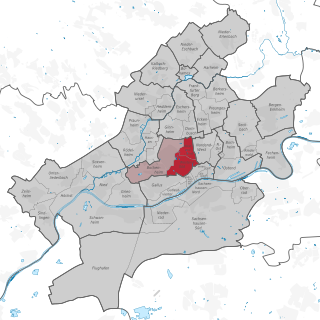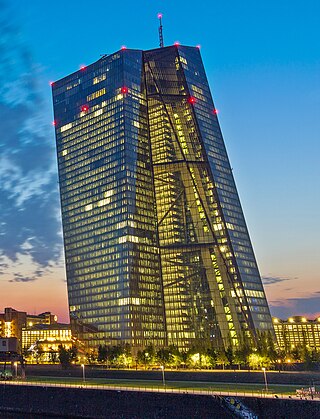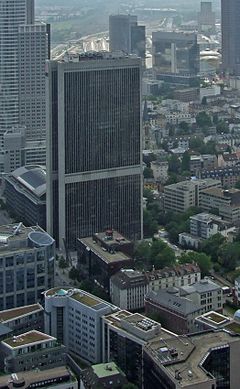
Frankfurt, officially Frankfurt am Main, is the most populous city in the German state of Hesse. Its 791,000 inhabitants as of 2022 make it the fifth-most populous city in Germany, and it is the only city in the country rated as an "alpha world city" according to GaWC. Located in the foreland of the Taunus on its namesake Main, it forms a continuous conurbation with the neighboring city of Offenbach am Main and its urban area has a population of over 2.3 million. The city is the heart of the larger Rhine-Main metropolitan region, which has a population of more than 5.8 million and is Germany's second-largest metropolitan region after the Rhine-Ruhr region and the fourth biggest metropolitan region by GDP in the European Union. Frankfurt's central business district lies about 90 km (56 mi) northwest of the geographic center of the EU at Gadheim in Lower Franconia. Like France and Franconia, the city is named after the Franks. Frankfurt is the largest city in the Rhenish Franconian dialect area.

Commerzbank Tower is a 56-story, 259 m (850 ft) skyscraper in the banking district of Frankfurt, Germany. An antenna spire with a signal light on top gives the tower a total height of 300.1 m (985 ft). It is the tallest building in Frankfurt and the tallest building in Germany. It had been the tallest building in Europe from its completion in 1997 until 2003, when it was surpassed by the Triumph-Palace in Moscow. Since the departure of the United Kingdom from the European Union, the tower had briefly reclaimed its position as the tallest building in the European Union only to lose the title again in 2021 when Poland's Varso Tower topped out. The Commerzbank Tower is only two metres taller than the Messeturm, which is also located in Frankfurt and was the tallest building in Europe before the construction of the Commerzbank Tower.

The Messeturm, or Trade Fair Tower, is a 63-storey, 257 m (843 ft) skyscraper in the Westend-Süd district of Frankfurt, Germany. It is the second tallest building in Frankfurt, the second tallest building in Germany and the third tallest building in the European Union. It was the tallest building in Europe from its completion in 1990 until 1997 when it was surpassed by the Commerzbank Tower, which is also located in Frankfurt.

Alte Oper is a concert hall in Frankfurt am Main, Hesse, Germany. It is located in the inner city, Innenstadt, within the banking district Bankenviertel. Today's Alte Oper was built in 1880 as the city's opera house, which was destroyed by bombs in 1944. It was rebuilt in the 1970s as a concert hall with a large hall and smaller venues, opened in 1981. The square in front of the building is still known as Opernplatz.

Frankfurt am Main Airport long-distance station is a railway station at Frankfurt Airport in Frankfurt, Germany. It is served by long-distance trains, mostly ICE services running on the Cologne–Frankfurt high-speed rail line. It is the largest railway station serving an airport in Germany with about 23,000 passengers each day. The station is served by 210 long-distance trains daily, of which 185 are Intercity-Expresses. It and Limburg Süd station are the only railway stations in Germany that are served exclusively by long-distance trains.

Westend-Nord and Westend-Süd are two city districts of Frankfurt am Main, Germany. The division into a northern and a southern part is mostly for administrative purposes as the Westend is generally considered an entity. Both city districts are part of the Ortsbezirk Innenstadt II.

Skyper is a building complex in the Bahnhofsviertel district of Frankfurt, Germany. The tallest of the three buildings is a 38-storey, 154 m (505 ft) skyscraper. Its quadrant-shaped silhouette is a distinctive part of the Frankfurt cityscape.

Frankfurt (Main) Hauptbahnhof, also called Frankfurt Central Station and Frankfurt Main Station, is the busiest train station in the German state of Hesse. Because of its location near the middle of Germany and usage as a transport hub for long and short distance travelling, Deutsche Bahn refers to it as the most important station in Germany.

The seat of the European Central Bank is situated in Frankfurt, Germany. The premises comprise a twin-tower skyscraper and the city's former Wholesale Market Hall (Großmarkthalle), with a low-rise building connecting the two. It was completed in 2014 and was officially opened on 18 March 2015.

Martin Elsaesser was a German architect and professor of architecture. He is especially well known for the many churches he built.

Westend Gate, formerly known as Plaza Büro Center, is a 47-storey, 159 m (522 ft) skyscraper in the Westend-Süd district of Frankfurt, Germany. It was the tallest building in Germany from 1976 until 1978 when it was surpassed by the Silberturm, which is also located in Frankfurt.

The Main–Weser Railway is a railway line in central Germany that runs from Frankfurt am Main via Gießen to Kassel. it is named after the railway company that built the line and also operated it until 1880. It was opened between 1849 and 1852 and was one of the first railways in Germany.

Frankfurter Büro Center, also known as FBC, is a 40-storey, 142 m (466 ft) skyscraper in the Westend-Süd district of Frankfurt, Germany. It was designed by architect Richard Heil from Frankfurt. The building's anchor tenant is the international law firm Clifford Chance.

AfE-Turm was a 38-storey, 116 m (381 ft) skyscraper in the Westend district of Frankfurt, Germany. It was the tallest building in Frankfurt from 1972-1974.
Eschenheimer Turm was a city gate, part of the late-medieval fortifications of Frankfurt am Main, and is a landmark of the city. The tower, which was erected at the beginning of the fifteenth century, is at once the oldest and most unaltered building in the largely reconstructed Frankfurter Neustadt, now better known as the Innenstadt.

New Frankfurt was an affordable public housing program in Frankfurt started in 1925 and completed in 1930. It was also the name of the accompanying magazine that was published from 1926 to 1931 dedicated to international trends in architecture, art, housing and education.

Städtische Bühnen Frankfurt is the municipal theatre company of Frankfurt, the largest city of Hesse Germany. The name dates back to 1919. The company is structured today in two organisations, Oper Frankfurt for opera, and Schauspiel Frankfurt for drama (Schauspiel).

The Willy-Brandt-Platz is a central square in Frankfurt am Main, Hesse, Germany. Its name was Theaterplatz until 1992, when it was named after Willy Brandt, the former chancellor. It is located between the Main Station and the Altstadt, at the Frankfurter Anlagenring, and is part of the so-called Bankenviertel. Major buildings are the Städtisches Opern- und Schauspielhaus, the municipal theatre that opened in 1963, and the Eurotower skyscraper. Below the square are the U-Bahnhof Willy-Brandt-Platz and the Theatertunnel street tunnel.

Post-war reconstruction of Frankfurt was the broad period from 1945 into the 1960s during which the city of Frankfurt am Main in Germany removed the rubble created by Allied raids and the subsequent battle by Allied ground forces to take the city and rebuilt the damaged parts of city.




















